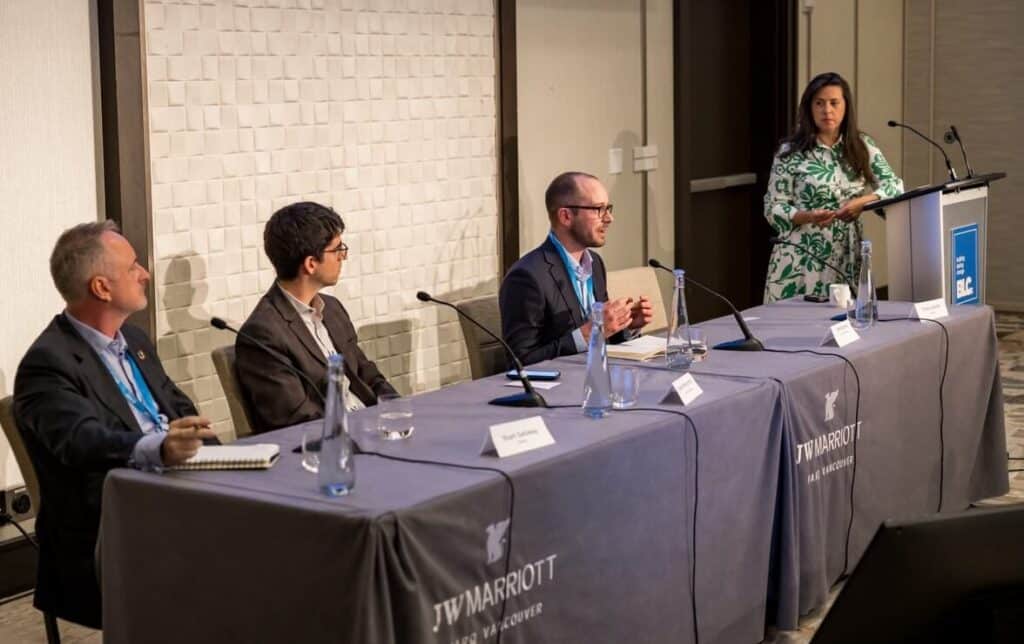Ask the expert: Tonya Lagrasta
CAGBC Staff on June 27, 2023
- Theme
- Member Profiles
As Head of ESG for Real Estate Management Services Canada, Tonya Lagrasta advances Colliers’ ESG leadership and the service offering to clients looking to establish and pursue their sustainability goals. Tonya has led the cross-functional integration of innovative ESG practices within multiple sectors, including property management, consulting, and retail, providing her with a unique vantage point to advise on industry best practices. We recently interviewed her about her approach to integrating ESG into business practice in the real estate industry.
You managed to start your sustainability career fresh out of university, at a time when sustainability concepts were not top of mind in businesses. Can you describe your career’s evolution?
When I started my career, sustainability in business focused on risk management and compliance. While I was fortunate to work for a company who was ahead of its time on prioritizing Environmental, Social, and Governance (ESG) initiatives, businesses predominantly viewed sustainability as a cost they were not willing to incur, rather than – among other things – an investment that had the potential to increase business performance and value. Sitting at my desk at Husky Injection Molding Systems, it would have been hard to imagine the scope and velocity at which sustainability is now being integrated into corporate strategies. I’ve gone on to develop carbon reduction targets for a global firm, developed the first ever disclosure strategy for national firm, and am currently advising multiple clients on their net zero transition plans. As my career has evolved, so has the level of interest, expertise, and yes, urgency, for heightened ESG performance across all industries.

As an advocate of building retrofits, how do you identify opportunities to accelerate retrofits?
Retrofitting is critical if we are going to decarbonize the building sector, but it’s not happening fast enough. Before we begin to talk about specific retrofits, our team at Colliers Real Estate Management Services (REMS) looks at where our clients want to be at the end – for example, net zero for scope 1 and scope 2 emissions by 2040 – and then reverse engineer how to get there. Retrofits are one piece of this strategy and could include minor retrofits, such as upgrading lighting systems, major retrofits such as installing low flow facets or submetering, or deep retrofits, such as replacing heating, ventilation, and air-conditioning systems with renewable technology. The key thing to remember with deep retrofits is the need to plan ahead – ideally during the capital planning process.
Colliers launched an Edible and Pollinator Garden program. How do you go about integrating nature-based climate solutions in your projects and how do they bring you closer to your ESG goals?
As reported by the World Wildlife Fund (WWF), nature-based climate solutions and broader land sector restoration could contribute up to 30 percent of the climate mitigation needed by 2050 to meet the Paris Agreement objectives. Our built environment can and must be activated in ways that help restore biodiversity.
The Colliers Edible and Pollinator Garden Program is among the industry’s leading nature-based strategic initiative. Across the country, the program is creating new community spaces, supporting wellness, advancing building sustainability certification goals, and enhancing urban biodiversity through use of native perennials. Gardens were launched at more than 40 Colliers managed properties across the country in 2021 and we are now on track for scaling to 80 sites in 2023.
Not only does the program support the “E” arm of ESG, but “S” as well. Each year, the gardens produce vegetables and herbs that are donated to local community food organizations. Furthermore, the program has sparked a partnership with nearby education institutions, including Durham College who supported the development of our garden at an industrial site in Whitby.
Increasingly, owners are recognizing the critical link between deep retrofits and improved ESG performance of their asset. How does one go about determining the scale of retrofits and subsequent investment needed to make a real impact?
It starts with a needs assessment. At Colliers REMS, we have developed our own set of ESG assessment modules to determine the risks and opportunities for the buildings we manage across material issue areas such as energy consumption, emissions, and occupant wellbeing. The type and recommended timing of each retrofit will look different for each property. What is required from an investment perspective is tied to the scale and pace of change required to deliver on the ESG performance goals of the asset.
Is it possible to give back to the community, be socially responsible, be mindful of the environment, and still be profitable?
Without a doubt. It would be foolish to not acknowledge that climate change and its impact to society will not be costly to business. The human and physical devastation caused by the rise of forest fires and flooding across the country in the past year is but one example that gives you a sense of the consequences of inaction. There was a time where prioritizing ESG was viewed as a “nice to have.” It soon became a license to operate. Now, it’s viewed by many as a license to grow. In the buildings we manage, for example, we’ve seen current and prospective tenants prioritize ESG in their decision making. Here, the correlation between action and profitability is becoming clear. That said, every ESG strategy will be different. In the case of our clients, it will be heavily dependent on the property type, the portfolio’s long-term goals, and the latest innovations in the market. We understand that the destination may be the same, but the path each building takes will be distinct.
You asked an interesting question at the Alternative Financing Models to Accelerate Retrofits session you moderated at BLC but we want to have your take on that: what is it we should be doing but we are not? How can we be more proactive?
The biggest thing right now is our pace.
We know Canada’s current building stock accounts for about one-fifth, or 17 percent, of the country’s total emissions footprint. The current annual rate of retrofits of Canada’s commercial building floor area is approximately 1 percent with retrofits achieving “shallow rather than deep energy savings,” according to a 2021 report by Efficiency Canada and Carleton University. At this pace, it’s estimated it will take 71 years to retrofit all commercial and public buildings.
Indeed, the rate of retrofits needs to triple annually by 2025 and will require an estimated $39-$62 billion per year as part of the industry’s effort to reduce emissions by nearly 40 percent by 2030. That means we need to retrofit nearly all the standing buildings in Canada.

It can be overwhelming for our clients to know where to start. But our teams break it down and prioritize what is most material to an asset or portfolio of assets. We develop tailored ESG performance plans that deliver on both owner and tenant goals, and respond to the growing expectations for enhanced disclosure.